Wouldn't it be luggerly?
12
12
|
|
Lug sail? Pah......watch this and feel old
http://www.sailingscuttlebutt.com/2015/06/21/merging-of-two-worlds/ |
|
|
But how do you stop the kites all getting tangled if there are a group of them?
Tim.
|
|
|
Kite surfing is fun.....but a mate a work broke his ankle in a heavy landing, due to a gust of wind lifting him up then dying. It's not for the faint hearted.
As for tangled ropes, there aren't enough nutters per kilometre of coastline. 
-Paul |
|
|
This post was updated on .
Seems wrong to claim that this is novel - many people have been combining kites and boats with varying degrees of success over many decades - indeed the idea is older than what we now call kite-surfing - ie. people had tried it with a boat before they ever thought of doing it with just a small board.
Here is a video of one of many current projects - I think this one even has some government funding in the US.https://www.youtube.com/watch?v=qrkrepYd_uI At least one kite boat has crossed the Atlantic ocean and I think also the Pacific ocean. Kite boats have not yet matched the highest speeds achieved by kite surfers, but the kite surfing records were all made in very shallow calm water with a beach just to windward, on the open sea perhaps it could be a different matter. Paul Larsen with the 'Sail Rocket' project has now taken the unlimited world sailing speed record well above anything achieved by kite surfers or kite boats (or any other kind of sailing boat for that matter) and has achieved this with much lower true wind speed than the kite surfing records. Kite surfers and kite boats have a definite advantage that the wind is steadier and stronger at the altitude of a kite. Against this, it seems unlikely that any kite could have the aerodynamic efficiency (lift to drag ratio) of a good fabric sail let alone a wing sail. The kite helps lift the weight of the water-borne part of the system but this is not 'free' lift - it comes with a drag penalty, although this drag penalty may compare favourably with alternative ways to generate lift. Replacing the kite with a high efficiency glider is an interesting possibility, although one would think that the drag of the tethering lines must ultimately impose a limit to the possible efficiency. |
|
|
As a former paraglider and paramotor pilot I can confirm that line drag is pretty high, second only to the drag of the pilot.
|
|
|
This post was updated on .
In reply to this post by AdrianG
A week late and a wad short, specially for you then Adrian
Simplicity and functionality Well, let’s see; what are the good and bad points of each type of rig? BERMUDAN Good points 1. It is the most efficient upwind sail That’s it; I really can’t think of any other advantages Bad points 1. Long mast and, though unstayed versions do exist, mostly relying to complicated staying with spreaders. 2. Small sail area, needing a badly behaved extra sail, the spinnaker for downwind work:  3. It is possible to have a luff sleeve, containing the mast and some cases may have a halyard - offering a crumpled, irremovable heap around the gooseneck, as opposed to being inserted before stepping. However, the mainsail is usually attached to the mast with a luff-rope and groove, or at least slides. None of the above ease setting, or furling; despite self feeders etc, the vessel has to be turned up into wind and the luff often hand-fed to prevent jamming, or there is rolling a sleeved sail round the mast. What a kerfuffle. 4. This is aggravated by the roach – the extra area achieved by a bowed leach held out with part, or full length, battens. Although there are one or two designs where the battens are close to vertical, many more are usually horizontal and anyway ignoring the friction associated with slides or ‘cars’, without the weight of a spar at the head, the sail has no great interest in dropping once the halyard is let fly and has to be manually hauled down. 5. A stayed mast, with three sails – main, jib and spinnaker. Even in a small dinghy, three stays, three halyards, five sheets and a kicking strap. Twelve bits of string in all and never mind reefing. All right for tearing up and down in speed machines for an hour or two, but pretty useless for convenience while short-handed adventuring. GUNTER (Gunter lug) This is a Bermudan rig with the mast cut in half, the top part having the upper part of the luff, or head as it has now become, permanently rove to it. One or both spars are a tad longer so they overlap in use, allowing the yard to stand vertically above the masthead. Good points 1. This is in practical effect, a Bermudan sail, with similar windward abilities. 2. The boat’s spars are now shorter and when reefed, the yard descends bringing the weight aloft nearer to the deck; unless you’re Cliff Martin. Don't get me wrong, I have the greatest admiration for Cliff and one day I'm going to ask him why he keeps the yard aloft and lowers the whole sail down yard and mast. I'll bet he has a good reason, (perhaps 2. under 'bad points' below). 3. The luff is no longer partnered with a track, but laced or better yet, held to the mast with sliding hoops, which unlike the lacing do not need to be adjusted on reefing and should not jam if properly set up. These arrangements also allow the luff to take up a better aerofoil position relative to the mast. 4. The sail is held aloft by a single halyard that when let fly will tend to bring the sail down under the weight of the spar; an instant relief, if not reef. Bad points 1. The main never seems to set quite as well as a Bermudan sail – the ‘throat’ at the bottom end of the yard needs careful cutting to prevent strange creases at this point. The other thing I have noticed is that the leach never seems to stand up quite as well as a Bermudan equivalent; they have a habit of stretching, with adverse effects on the sail shape. 2. This saggy leach business is aggravated by reefing when measures have to be taken not to allow the top of the yard to bend off to leeward But, bring on the Mirror, the greatest little gunter in the world:  GAFF Good points 1. Now I have to admit this is one of my favourite mainsails; in its most basic form it is a laid back gunter, with all the advantages. The yard angles up and aft, off the mast and this forms a definite ‘corner’ at the throat, making the sailmaker’s job that much easier. There are two halyards – a ‘throat’, which tensions the luff below that point and a ‘peak’ which pulls the gaff itself up until the sail is as round and smooth as, and here I shall quote my Dear Old Dad “….a maiden’s bottom”. Of course this is utterly politically incorrect and I wouldn’t dream of saying such a thing myself, but his words still ring in my ears down through the eons. To come to the point; unlike the single halyard gunter, it provides excellent control over the tension in the leach and therefore sail shape. 2. A quadrilateral sail can provide more area on shorter spars and when reefed, reduces the weight aloft. 3. Luff lacing, or hoops provide the better aerofoil and lack of jamming mentioned above. 4. Let the peak halyard fly and the sail is instantly halved – ‘Scandalized’. In fact, in extremis you can tie the gaff peak itself to the boom, producing a three sided sail referred to as a ‘Spanish reef’: 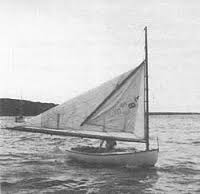 I’ve never done it; a full Spanish reef that is, lowering the peak to scandalize the sail I use all the time. Bad points 1. The gaff is notorious for the amount of string it engenders, but it does not normally sport a kicking strap and I would swap one of those for the requisite extra halyard any day, meaning that the actual number of pieces stays the same as the two rigs above. The only problem is that on a sail of any size one starts to need extra purchases – blocks to get the require tension, so the working and therefore coiling, parts of the lines are twice, or more, times as long. 2. The lug rig which I am coming to soon is so useful, that I prefer it over the gaff for sails up to about a hundred square feet, after which the free standing luff on the lug can get ideas above its station; ask Richard Rooth. 3. The triangle left between the masthead and the gaff encourages beady eyed sailors to put some more canvas up there – the topsail; this is a monster that vies with the spinnaker for unruly behaviour. You can not only fill the space, but you can extend both the fore and aft edges of it with extra spars – topmast poles and jack-yards and the like. Terrible; three extra pieces of string – a halyard, a sheet and a downhaul and the opportunity to fly off to leeward, or capsize on the way up and all sorts of other tricks; it almost never set first time for me. The sensible thing to do is have a gaff with a high peak – close to the mast so that the hole is just not worth filling. These are the two gaffy girls in my life: 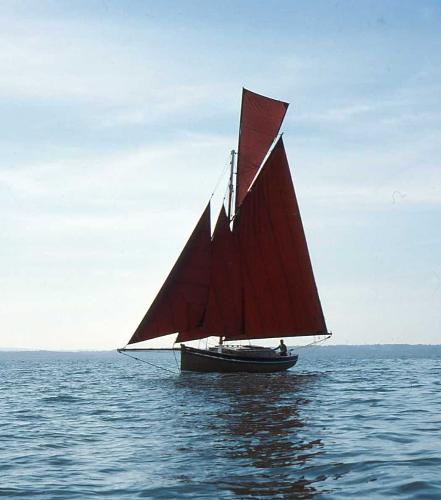 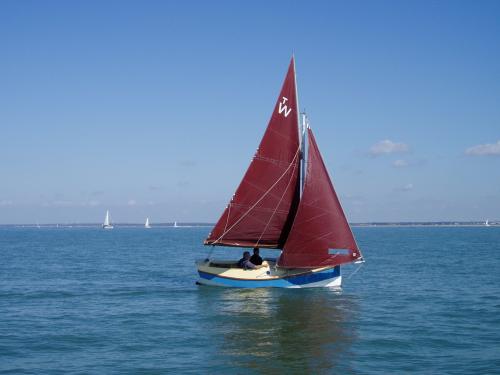 SPRIT Good points 1. It's quadrilateral so like the other four sided sails you get more area on a shorter rig. 2. you can brail it if you're brave enough. Bad points 1. Particularly when boomless, it bellys horribly just when you most need it to be flat: 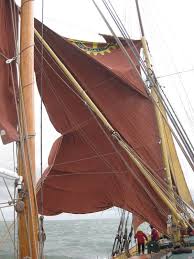 2. It is a nightmare to reef. JUNK Good points 1. It's easy to reef Bad points 1. Makes the gaff look quite naked from a string point of view. 2. It's just a lug sail with a bunch of bamboo battens knocking the shape out of it. 3. The name says it all really (Oops, there goes the cat among the pigeons). LUG Of which there are three recognized sorts; in this country at least Good points 1. The sail is at least as happiest on an unstayed mast and in its most basic form, only requires two pieces of string – a halyard and a sheet. That’s better than twelve, isn’t it? In fact for very little ones, you could clip the yard to the masthead and then step the mast, doing away with the halyard as well. 2. Again the quadrilateral sail allows you to set more area for shorter spars. Bad points 1. On one tack, the sail will lie against the mast, spoiling its aerofoil shape a tad, unless you ‘dip’ it; that is move it to leeward of the mast each time you go about. This is a pain you don’t need and is pretty much essential on a dipping (1) lug – hence the name. This is where the ‘tack’ of the necessarily boomless sail is unhooked from ahead of the mast, manhandled aft and round and hooked up again on the other side; this may require temporarily slacking off on the halyard. It is also preferable on a standing lug, to get it to set better. The tack on a standing (2) lug is attached to the back of the mast, at the level a gooseneck would be mounted if a boom is used and this is a matter of design preference. 2. A balance (3) lug necessarily has a boom that goes past the mast and in practice it would be so laborious to move the sail and boom to leeward at each tack that I’ve never heard of it being done. In practice this does not seem to make as much difference tack to tack, as one would suppose…. And, gosh, it’s simple! Just imagine a Roman orator holding out a scroll by its top and bottom rolling pins, or whatever pointy sticky-things (knitting needles?) his wife has allowed him to use out of the kitchen draw. As he verbositizes in the forum, he stretches it out and keeps it flat despite the afternoon breeze wafting in up the Tiber from the Tyrrhenian sea, just holding it by two locations on those sticky-things. Well, that’s what the halyard and a teensy-weensy strop holding the boom down onto the mast do, on a balance lug. Then just pull in on the sheet to fill your gently curved piece of canvas and off you go…. 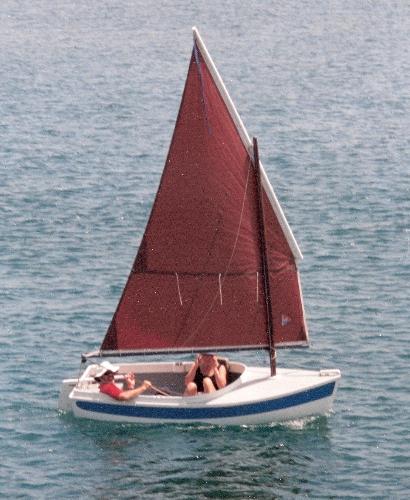 My favourite Now I am sure there are those out there who could quibble about battens they have known and the advantages of having two halyards on a gunter rig and endless other quirks, but are there fleets of such dinghies at your local club? Not so many, perhaps? Ol’ Goatitude |
|
|
A most efficacious reply by Chris - you asked Adrian!
Handling the long, heavy Enterprise mast was a struggle single handed; I always asked for help if anyone was around. There again the Enterprise was designed as a 2 man racing dinghy. Also raising the sail was difficult in a blow, often sticking in certain places whilst simultaneously dodging big boats at Cobnor and heading towards rougher water at Itchenor. It's a good recipe for a heart attack. So I'm switching to an easier Gunter rig. An extended main mast of the old Vanguard rig that Chris donated to me from a friend of his. It has been stretched to a tad over 13ft by splicing on about 2ft of MilliBee's old boom, which was a cut down (broken) mast from an unknown dinghy. Don't you just love upcycling! The lighter colour extension was wider and my belt sander blended the two nicely: 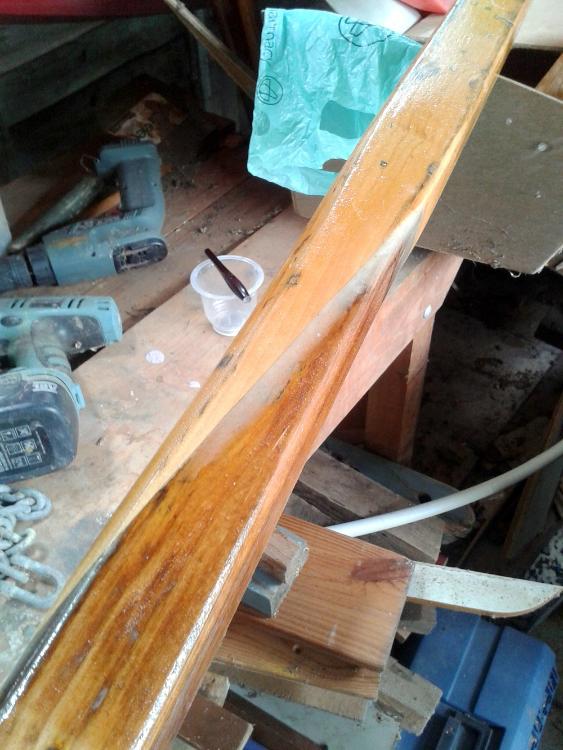 The Gaff is just over 10ft so I can carry a large range of sails. At 13ft the main mast fits within the 14ft boat length, so towing becomes simpler as all spars fit in the boat. The extended main can now fit a Wayfarer genoa for lighter winds. Here is a prototype setup that Chris and my self made a while ago. Remember now the cabin is 3in lower and the main mast is longer......so the genoa should clear the cabin and catch as much wind as possible. 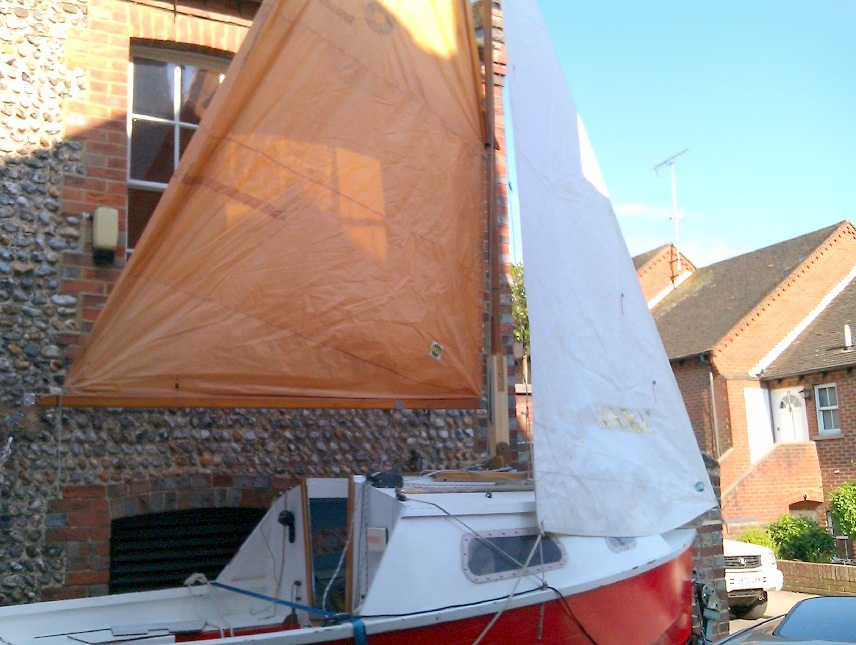 The net result, as Chris explained, is a much easier rig to handle plus I have 5 sails I can fit: the Vanguard main, the Vanguard jib, Wayfarer genoa (G1), a genoa from my Dad's old boat (G2) with a higher clew and the small lug sail from Illusion which was a cut down Mirror sail which will made a good storm sail using the new spars....plus one extra uphaul for the gaff throat. I could even fit a version of the Paradox roller blind within the limits of the 13ft stayed main - again good for stronger winds. Performance wise we will see, but the new centreboard will dominate upwind performance. BTW: Dave Sumner uses a cut-down gaff sail on his Mirror in strong winds in the Solent. He likes the stable low down power. When the wind lightens he fits a top sail to fill in the gap. -Paul PS Did you spot the prototype bowsprit? |
|
|
In reply to this post by Chris Waite
Yes, but that is the only thing that really matters, is it not? Anything will drift pleasantly in the other direction, even a bermudian rigged boat without a spinnaker. Says me with tongue only partly in cheek But that's a great summary Chris, if a little biassed - sort of thing Keith M would probably appreciate for the DCA journal or website. Anyway - Josephine and myself are just packing ready to get our car and boat on the ferry to Spain with a view to doing some dinghy cruising in Galicea. Have never been there before but it looks nice on Google Earth. The plywood for the rowboat that I mentioned here is still at the firm that said they would cut it all out for me - they said it would only take an hour or so, but I suppose thats from when they actually start! Doesn't matter though, we would rather spend the summer outdoors and make boatbuilding a winter hobby. |
|
|
Thanks for taking the time to write such a clear summary of your thoughts on rigs, Chris - complete with pictures - very nice. I'm sure I'll not be the only one carefully reading that post and pondering what you say - it's always thought provoking and educational to read the opinions of those with experience - cheers.
And good luck & bon voyage, John & Josephine - have a safe and fun journey. I look forward to reading the subsequent DCA article. Kind regards Adrian |
|
|
Well we made it safely to a Corunna starting from San Esteban near Gijon, which was our original plan. We are now berthed Corunna, have been looking around the interesting city. Is anyone interested in a short cruise following the DCA 60th anniversary celebration at Cobnor on 22nd august.? I think Alastair Paul and Gerald did express interest a few weeks ago. John |
|
|
There is an other interesting boat in A Coruña : Yann Quenet's Skrowl !
Furling standing lug (just like the Paradox), we respect the subject ! He arrived 2 days ago, from Brittany. I Don't know in which part of the harbour he is, I'll send him an email.... 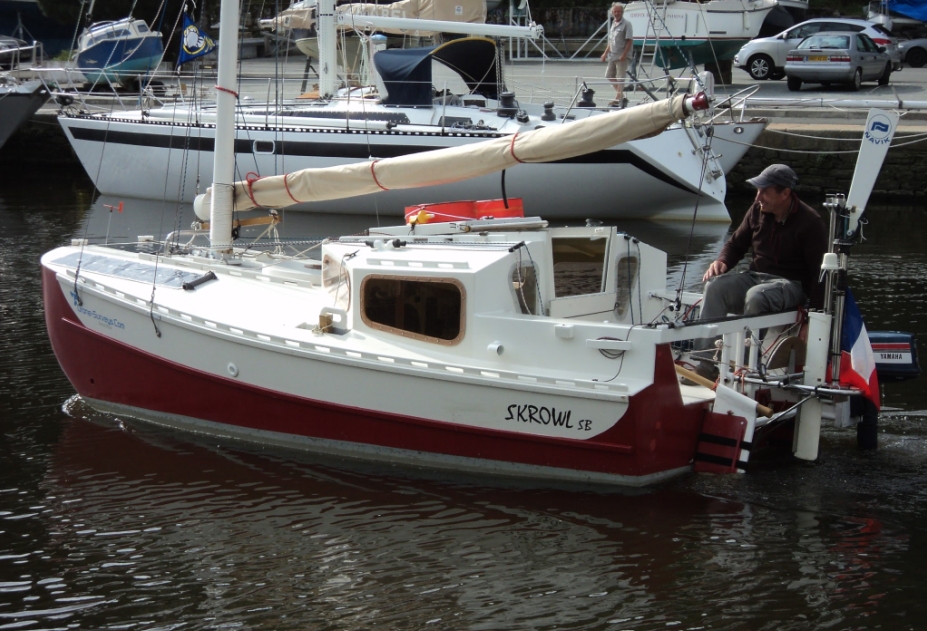
|
|
|
In reply to this post by John P
On 25 Jul 2015 at 14:00, John P [via UK HBBR Forum] wrote:
> Is anyone interested in a short cruise following the DCA 60th > anniversary celebration at Cobnor on 22nd august.? I think Alastair > Paul and Gerald did express interest a few weeks ago. John I'm still in. -- Sail when you can, row when you must, motor when you have to be at work in the morning. Alastair Law Yeovil, England. <http://www.little.jim.freeuk.com> |
|
|
In reply to this post by John P
I might have mentioned this before, but the best way of going upwind is rowing.
So the optimum sailing rig is a lugsail plus a good long pair of oars. He says, tongue almost entirely out of cheek... |
|
|
Well, if you like rowing and don't like sailing, then rowing will be the best way, but not necessarily the quickest. In a flat calm rowing will obviously be quicker than sailing, but for any reasonably good sailing boat I would have thought there would come a point at which that will be reversed, even for a windward course. The wind speed at which that happens will depend on the size and type of boat, the sea state and the length of the passage, so I don't think it makes sense to suggest any particular Beaufort number.
I can say that the wind speed at which we would choose to sail our boat to windward rather than row is quite low, even though our boat is probably a better rowing boat than most sailing dinghies (9 foot oars, a good rowing position and a fairly narrow waterline beam, although it is a heavy boat and usually loaded with a lot of camping equipment. The other day we had to make about 20 miles with flat calm alternating with light headwinds (coast of granite cliffs and no alternative harbour). We were rowing most of the day but were very glad when the slightest breeze came to give us a rest, even though it was always from dead ahead. When Phillip and Jeremy sailed their wayfarer round Britain in record time last year they reckoned that rowing was so slow that it was not worthwhile to even have a pair of oars on board, although they did take paddles for manoeuvring in harbours. The wayfarer is however a awkward boat for rowing. |
«
Return to General Discussion
|
1 view|%1 views
| Free forum by Nabble | Edit this page |

